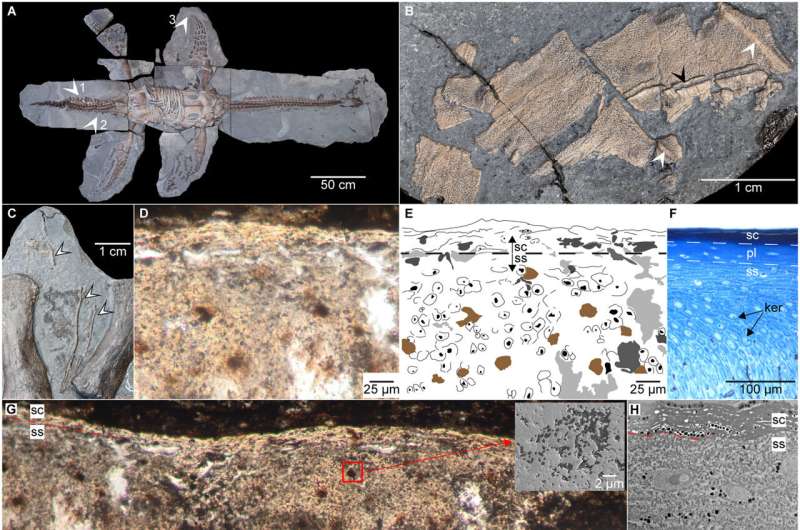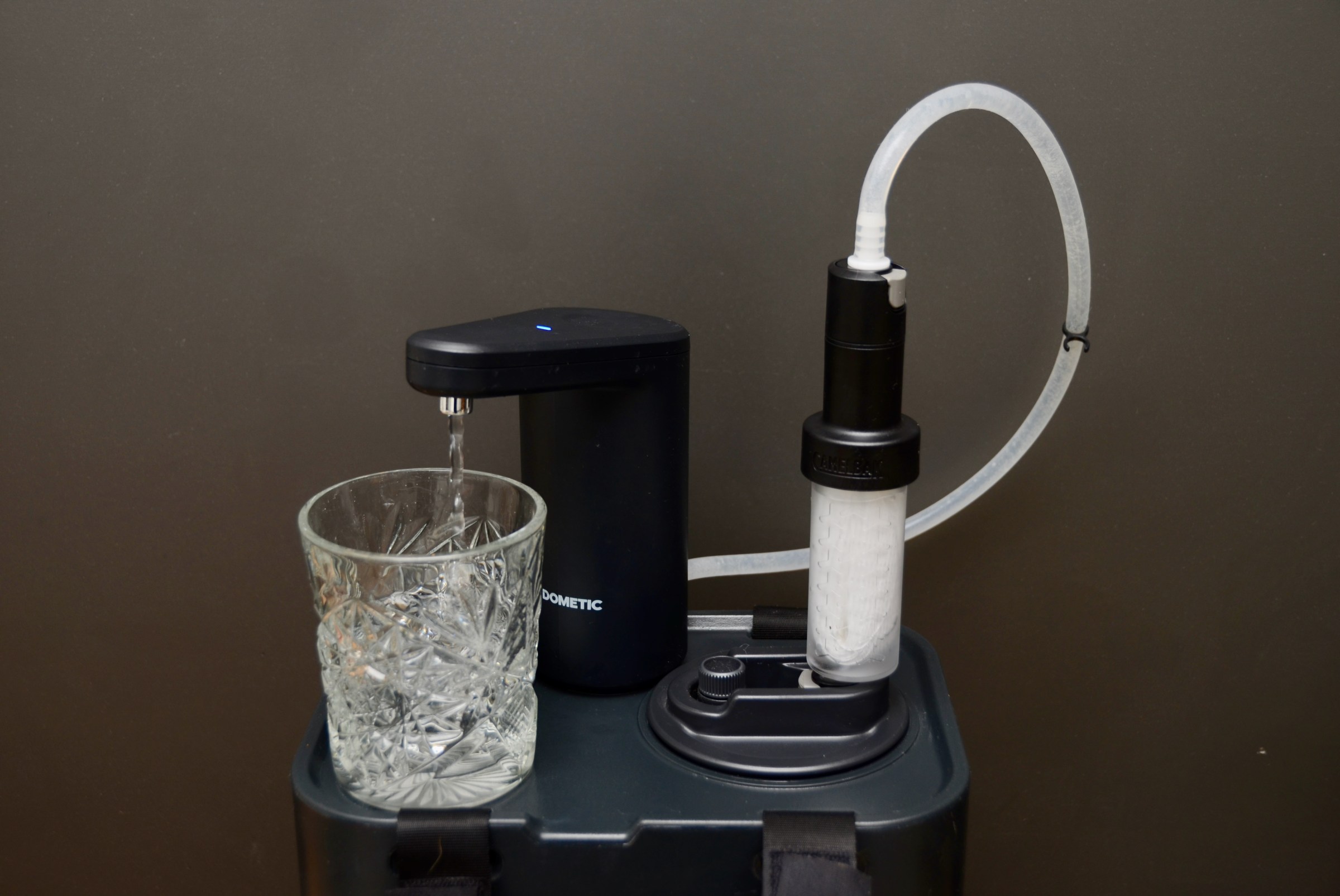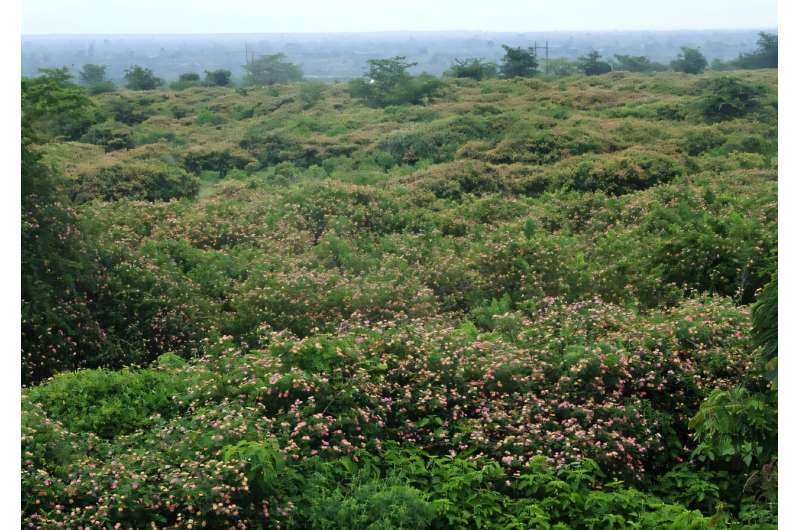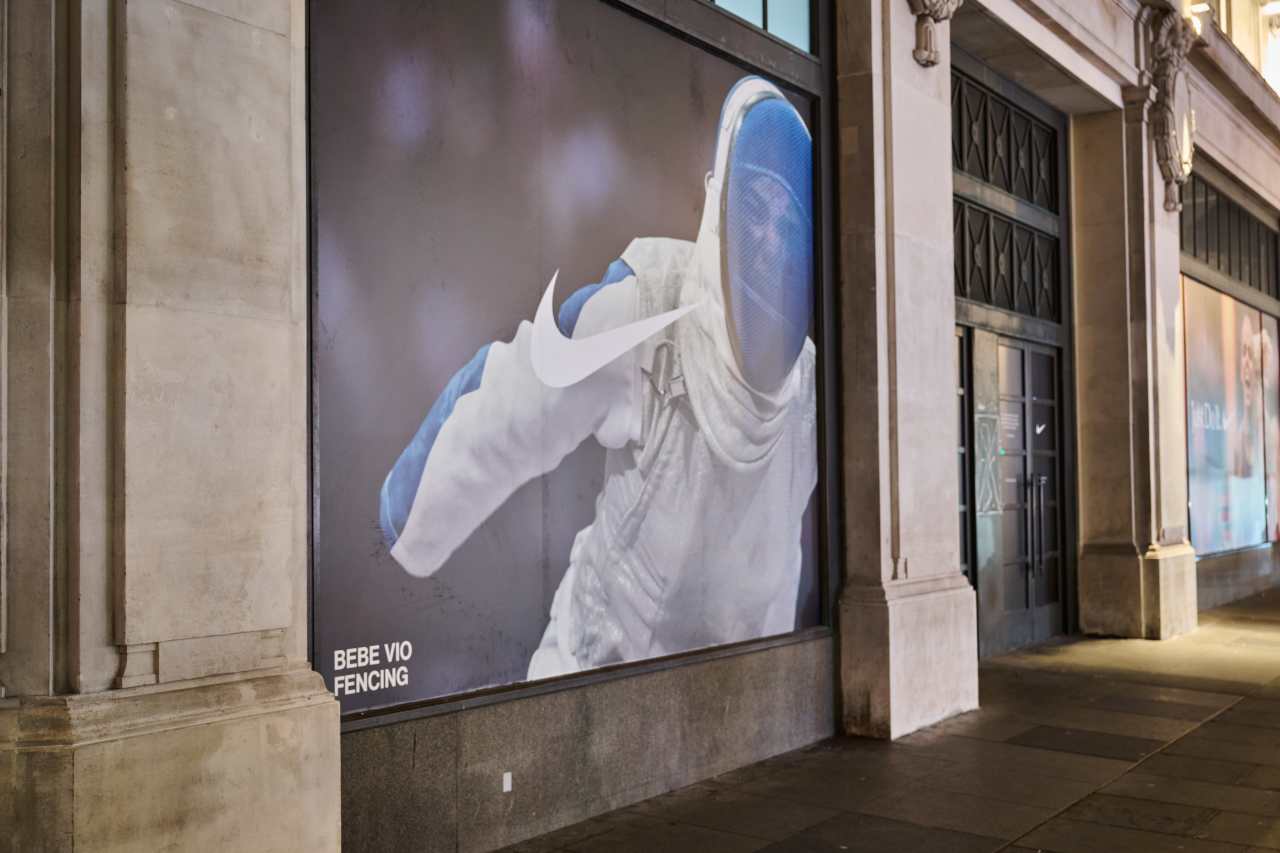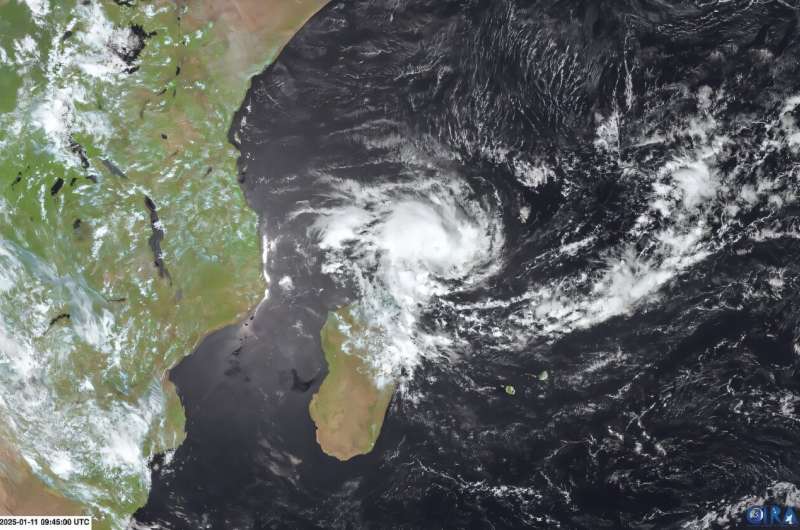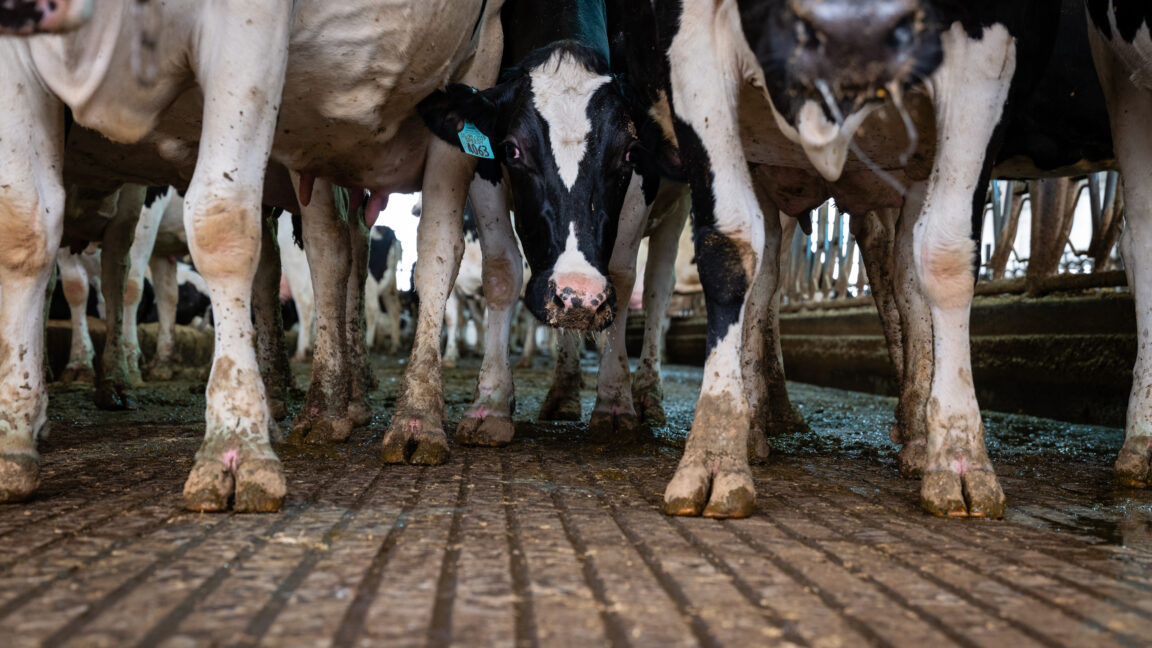Access to water is always a concern when heading off the grid in my van — not when I’m home in Amsterdam, a city surrounded by the stuff. That certainty changed recently when government ministers began quietly prodding citizens to stock up on emergency supplies due to an increased risk of armed conflict and other regional unpleasantries.
One recommendation, of many, is to have three liters (almost one gallon) per person per day on hand, or 15 liters per day for my five-person household. That means 105 liters for just one week or 450 liters each month! I don’t have space for that. Who does?
So, I started thinking: why not augment my emergency freshwater stores with a filtration and purification kit that can adapt to all the water sources around me? And since I’m a budding vanlifer and chronic adventurer, let’s make it portable so I can take it anywhere.
A double-tap of the Dometic Go faucet produces clean drinking water from the LifeStraw filter snapped into the Go jug.
I came up with this as a first-time prepper: pairing quick-connect water filters like the $42 LifeStraw sold by Camelbak with Dometic’s portable 11-liter Go water jug ($69.99) and its rechargeable Go Hydration Water Faucet ($99.99). Dirty water goes in and clean water comes out with a double-tap on the faucet. It even has a light!
If Europe is indeed returning to a state of turmoil, then I’ll be sipping clean water — pinky extended — from this luxurious 21st-century setup, at least until the electricity shuts off. Even then, I’ve made contingencies, including protection from gene-altering viruses found in zombie poop. You can never be too careful.
Let me be clear: this isn’t a review, despite having tested everything in the kit. It’s a newbie survivalist’s best guess at what will support my nomadic vanlife adventures while keeping my family hydrated when doomsday comes. Suggestions welcome.
Filtration versus purification
My primary filter is the LifeStraw cartridge because it has an integrated quick-connect adapter that easily snaps into the Go jug’s CPC coupler. It features two stages of filtration. The hollow fiber filter physically removes bacteria and protozoa that cause diseases, as well as dirt and microplastics, and has a lifespan of 4,000 liters (1,000 gallons). Meanwhile, the activated carbon filter removes things like odd tastes and smells. It has a lifespan of just 100 liters (25 gallons), and a two-pack of replacements can be had for $13 a pop.
Using the Go faucet to pump water out of the Go jug through the in-line LifeStraw filter reached 0.5 liters in 40 seconds, or 36 seconds without a filter in between. I also have a small MSR filter that needs a wee bit of 1/4-inch tubing and a quick-connect adapter to snap into the Go jug. It filtered 0.5 liters in 38 seconds.
Left to right: the MSR Guardian purifier, the LifeStraw filter, the MSR filter.
The kit is highly portable and works with any filter (like the LifeStraw pictured) or purifier that can be adapted to CPC connections or Nalgene openings.
The replaceable activated carbon filter found inside the LifeStraw.
A closer look at the pore size of the LifeStraw’s hollow fiber filter.
Filtration is fine for removing biological pathogens commonly found in the waters of North America and Europe, but I also want protection against smaller bacteria and waterborne viruses found in places without well-maintained sewage systems. In vanlife, you never know when a dirty hippie is dropping a deuce upstream.
I splurged and spent $200 on an MSR Guardian water purifier with a pore size of just 0.02 microns, compared to about 0.1 to 0.2 microns for filters sold by LifeStraw, Sawyer, MSR, and others. For perspective, the anthrax bacteria measures about 8 microns; giardia, E. coli, and salmonella exist in the 0.5- to 2-micron range; and viruses spread by human excrement typically measure between 0.01 to 0.3 microns, according to MSR. The Guardian purifier is therefore my go-to solution when I need to go nuclear on a suspicious water source.
$200 is expensive, but the Guardian cartridge is rated for over 3,000 liters (almost 800 gallons) of water before needing replacement. Using MSR’s purifier creates far less waste than 3,000 liters of bottled water, which would also cost me about $1,250 at my local grocery store — and that’s before prices spike during a crisis.
The MSR Guardian purifier requires a quick-connect adapter to snap into the Go jug. Unfortunately, the rechargeable Go faucet does not produce enough suction to draw water through the Guardian cartridge. But that’s okay; it can slowly purify water if I remove the Go faucet, turn the Go jug upside down, and set it on top of my van to act as a gravity-fed system.
The Go jug paired with MSR’s XL gravity bag and Guardian water purifier cartridge. It’s going to take a real emergency to drink Amsterdam canal water.
Better yet, I’ve augmented my setup with MSR’s AutoFlow XL Gravity Filter 10L. The idea is to hang the bag high in a tree and wait for all the dirty water to flow down into the Go jug through the cartridge for purification and / or filtration — no pumping required. That way the Go jug can be 100 percent dedicated to clean drinking water.
MSR’s $129.95 gravity bundle includes everything you need to filter lots of water for multiple people: a 10-liter water bag with an integrated quick-connect coupler, long stretches of tubing, and a Nalgene-compatible cap that connects to the tubing and screws onto the Go jug. It also comes with a small MSR filter with a 1,500-liter lifespan, but the gravity system works with many inline cartridges, including my LifeStraw filter and the MSR Guardian purifier.
Total capacity: over 8,500 liters (2,250 gallons)
Total price: $566.93, compared to about $3,600** (plus waste) for bottled water
MSR says its Guardian purifier has a maximum flow rate of 0.5 liters per minute, which is accurate in my testing at sea level, when the gravity bag is hung at about six feet (183cm) or higher. The MSR filter that came with the bag took just 35 seconds to filter 0.5 liters of dirty water, while the LifeStraw filter took one minute, just like the purifier. I’m fairly certain I can speed that up with a 90-degree quick-connect adapter that lets the LifeStraw hang vertically.
I like these inline filtration / purification cartridges because they’re so flexible. For example, if I have to travel light, the LifeStraw and MSR filters can be used to extract water directly from a stream, jerry can, barrel, puddle… whatever — just dangle the backside water tube into the source and start sucking.
The LifeStraw’s integrated quick-connect link also clicks right into my Camelbak Chase backpack, which holds a 1.5-liter water bladder for my personal use. It’s the hydration bag I’ve been grabbing for the last few years when mountain biking, trail running, or hiking. The LifeStraw adds extra bulk and weight to the lightweight and diminutive pack and requires about 20 percent more suction to drink. The water bladder can also be hung from a tree to serve as a makeshift gravity filter.
I tested the Dometic Go jug and Go faucet while traveling around Europe in my van last summer, but I never found it that useful. It’s only after adding an inline filter — something Dometic doesn’t sell, but should — that I can finally see their combined value.
Water inside or out after adding a few extra meters of the water tubing.
One issue I had with Dometic’s Go jug was the plastic taste it produced when water was stored for longer than a day. That’s despite the receptacle being made from BPA-free food-grade plastic. I probably could have solved this had I cleaned it properly with an unscented bleach solution, but I didn’t have any. It has two openings: one is Nalgene-compatible, while the other larger opening makes it easy to fill and reach inside to clean. Nevertheless, trying it now with a filter attached has fixed the problem.
I also hacked the Go faucet to extend the hose with some 1/4-inch food-grade tubing found at my local hardware store. That way I can safely strap down the Go jug in the rear of my van (a distance of about two meters) while the faucet is mounted on its magnetic base next to the sink.
The Go faucet on the left is dedicated to clean drinking water; the other to washing up or water to boil for tea and coffee.
The Go jug packed away safely in the rear of my van.
This gives me a choice between two taps of running water: one for filtered drinking water, the other for unfiltered water I find along the way that’s dubiously potable (according to signage or locals) and stored in a 20-liter jerry can I keep under my sink. The latter I boil — killing all pathogens — for tea and coffee and use for washing up or hydrating the dog. This setup should help me extend the life of the filters and purifier.
The Dometic Go faucet is a luxury, but I kind of love it. A double-tap on the faucet starts the water flowing for one minute before automatically shutting off to conserve that precious resource (a single tap shuts it off). The Go faucet has an internal battery capable of 150 liters (almost 40 gallons) per charge.
1/18Everything works together with 1/4-inch tubing and CPC adapters.
I’m fairly confident my water filtration and purification kit will serve me and my family well, but I worry I’ve missed something. For example, this kit can’t handle water polluted by chemicals or toxins, and it requires regular care to avoid cross-contamination and to stop mold and bacteria from growing inside the system when not in use. But what are the known unknowns I don’t currently know?
I won’t be able to fix it with an Amazon delivery if shit goes down and supply chains are disrupted — so any tips from the big brains… braaaaaains… of The Verge reader collective are welcome.
Photography by Thomas Ricker / The Verge



